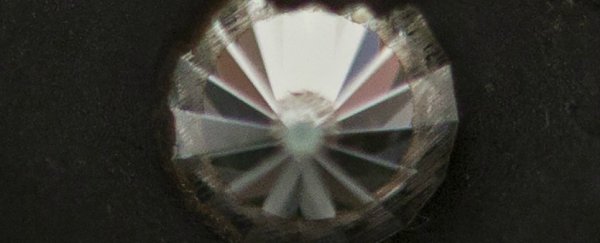When most people think about the hardest naturally occurring material on Earth, they think of diamonds - those pretty stones in our engagement rings that can cut steel and rock.
But scientists have been gradually improving on that toughness over the past few years, and now a team of Australian researchers has just created a rare type of diamond that's even harder than diamond.
This diamond is a version of Lonsdaleite, which has been found occurring naturally at the centre of a handful of meteorite impact sites around the world.
It's special because most diamonds are made up of carbon in a cubic lattice, but Lonsdaleite has a hexagonal lattice, which makes it up to 58 percent harder than regular diamond.
Now researchers have been able to make a nano-scale version of Lonsdaleite in the lab, and they predict that it's even harder than the naturally occurring version.
 Jamie Kidston, ANU
Jamie Kidston, ANU
It's so strong, in fact, that the team suggests its most immediate use will be in mine sites, where it can cut through ultra-solid materials, including regular diamonds.
"The hexagonal structure of this diamond's atoms makes it much harder than regular diamonds, which have a cubic structure," said lead researcher Jodie Bradby from the Australian National University.
"We've been able to make it at the nanoscale and this is exciting because often with these materials 'smaller is stronger'."
The team was able to create the new material by nanoengineering the diamond from scratch using a type of carbon that doesn't have a set form, known as amorphous carbon.
Lonsdaleite was first discovered in the Canyon Diablo meteorite site back in 1967, and researchers have managed to make it in the lab before, but without great success. And it takes incredible temperatures of around 1,000 degrees Celsius (1,832 degrees Fahrenheit) to actually form the diamond.
Instead, Bradby and her team took a different approach.
They put this carbon into a device called a diamond anvil, which is made of two diamonds opposing each other to recreate the high pressures you'd find deep down inside Earth.
You can check it out in the video below:

Using the device, they were able to create the diamonds at temperatures of just 400 degrees Celsius (752 degrees Fahrenheit) - around half as hot as previous methods, which means it's a lot cheaper and more efficient. And the end result is also a lot harder.
The researchers now need to go through further testing of this structure to find out exactly how tough it is compared to existing materials, but if natural Lonsdaleite is anything to go off, they're expecting it to be pretty hard.
"This new diamond is not going to be on any engagement rings. You'll more likely find it on a mining site," said Bradby.
"Any time you need a super-hard material to cut something, this new diamond has the potential to do it more easily and more quickly."
The research has been published in Scientific Reports.
